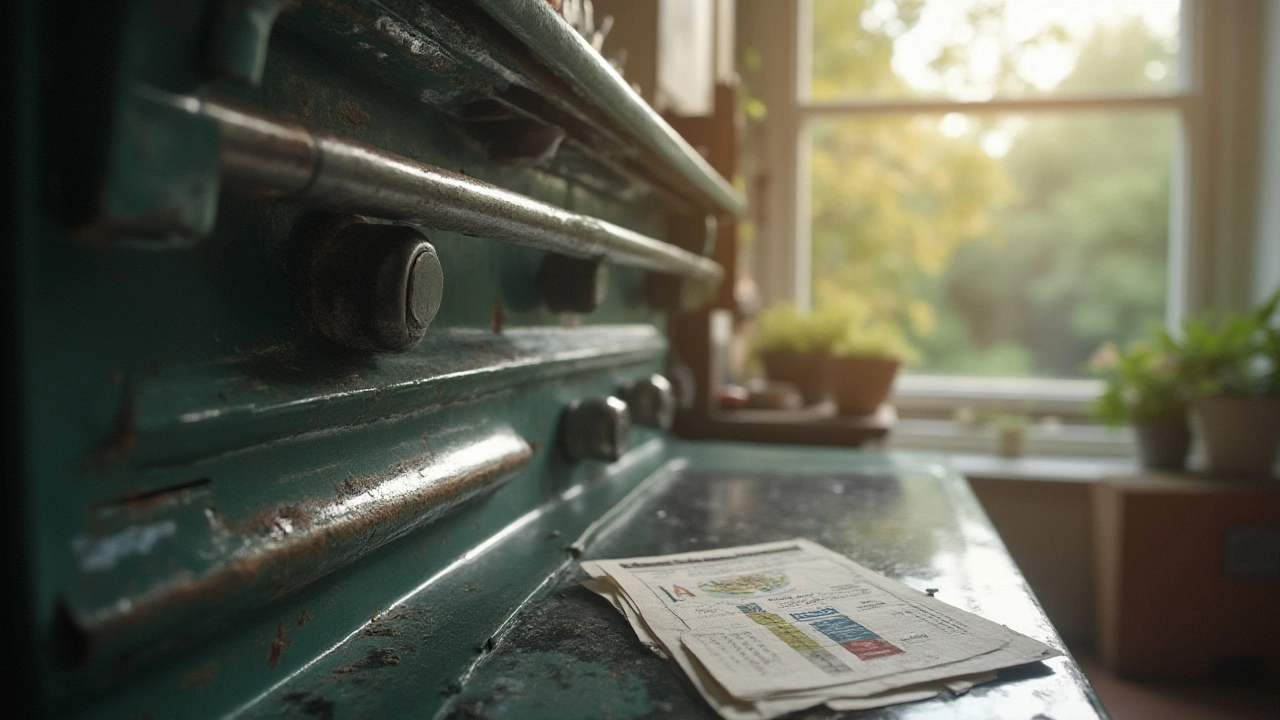Picture this: it's dinner time, your kitchen smells like burnt cheese, and your 7-year-old oven just fizzled out on you—again. You're standing there, phone in hand, toggling between repair quotes and new oven prices, wondering if you're about to dump money into a lost cause. Ovens aren't cheap, but neither is eating out for the next month. Is fixing that old workhorse really a smart play? Or is it time to let go?
Breaking Down the Real Cost: Repairing Versus Replacing at 7 Years Old
Let’s lay it out with real numbers. According to the U.S. Department of Energy, the average lifespan for an electric or gas oven is around 13-15 years if you treat it right. A 7-year-old oven is basically at its halftime break—not ancient, but not fresh out of the box. If you’re facing a minor repair, like a failed heating element or a broken seal, you might only drop $120-$250, parts and labor included. But if you’re caught with a dead control board or your oven just won’t heat evenly anymore, now you’re looking at $400 or more. Yikes.
Those numbers matter because the average new freestanding oven costs somewhere between $650-$1,400—a built-in model could hit $2,300 or more. Installation fees can add another couple of hundred, especially if gas lines or cabinetry are in play. Common sense says, "If the fix is half or more of the price of a new oven, start shopping." And Consumer Reports agrees:
“Appliance repair is worth it only when costs are less than half the price of a new appliance, and the oven isn’t near the end of its expected life.”
Don't forget the hidden costs either—if your oven is hauling your electric bill up or you’re paying every few months to keep it chugging, you might be bleeding money without even realizing. Modern ovens can be up to 30% more efficient, sometimes even more if you upgrade from an old-school coil to convection or dual fuel, and that can show up as savings down the line.
| Oven Age | Repair Cost (Avg.) | Replacement Cost (Avg.) |
|---|---|---|
| Under 5 years | $100-$200 | $650-$1,000 |
| 5-10 years | $150-$400 | $900-$1,400 |
| 10+ years | $250-$600 | $1,000+ |
So, is your 7-year-old oven worth fixing? If the quote’s under $350 and you haven’t spent much in repairs lately, patching it up makes sense. If it’s crossing into new-oven price territory or it’s on its third or fourth fix, you’re likely just delaying the inevitable.
What Parts Usually Break – And What’s Actually Worth Fixing?
Some oven problems are like potholes: quick to patch, not a sign of worse things lurking underneath. Others are like blown engines—they’re a sign that you’re in for a rough road. Here’s what typically goes south in a 7-year-old oven, and whether it’s a dealbreaker.
- Heating element, bake or broil: If your food’s undercooked or the broiler won’t brown, the element’s usually the culprit. Swapping it out is pretty cheap and almost always worth it, unless you’re facing a labor-intensive built-in model.
- Oven door seal/gasket: When you notice heat leaking, burned cabinet edges, or uneven baking, this rubbery seal has probably had its day. At $40-$80 parts and labor, call it a no-brainer fix—especially since lost heat costs you every night you cook.
- Thermostat malfunction: If your cookies keep burning or your roast never cooks through, the thermostat may have lost its marbles. This could run $120-$250. Worth fixing at 7? Usually yes, unless you’re facing old wiring gremlins too.
- Control board: Now it’s getting iffy. A new control board can be $250+ for the part alone. Figure another $100 for install at least. If you’ve already swapped this once before or your warranty is expired, this can tip you into "just replace the oven already" territory.
- Strange smells, gas leaks, or recurring circuit trips: Shut it down and call in a pro. These aren’t DIY-friendly and could be safety issues rather than just a failed part. If your warranty is toast and you keep having mystery issues, that’s a strong hint that your oven’s best days are behind it.
One trick: check if your oven is famous for quirky breakdowns. Some models have known weak spots that show up after 6 or 7 years. Search your make and model online—if you find a ton of matching horror stories, it may predict what’s about to break for you next.
Also, look at your calendar. Has your oven spent more time with a repair tech than you in the last 12 months? Has it missed its annual cleaning? Repent, and start fresh. Sometimes, it’s better to put your time and money into a model that won’t flake out during the next holiday dinner.

Hidden Perks of Upgrading and the True Cost of Clinging to the Past
It’s not just about the sticker price—old ovens vs. new ones sit on opposite ends of the tech evolution spectrum. That aging appliance probably wastes more power, takes longer to preheat, and spreads heat less evenly. According to Energy Star, swapping from a 10-year-old, standard oven to a new, energy-efficient model can save you around 20-30% in energy costs annually. Doesn’t sound huge? Add that up over another 7 years—now you’ve got some real money for pizza nights.
Modern ovens come with all sorts of perks: better insulation, self-cleaning features (that actually work), faster preheat options, smart controls you can set from your phone, even built-in air fryers or steam bake. Are you struggling with burnt cookies on the bottom rack but soup barely bubbling on top? That’s old-school oven design to blame—newer ones solve this with zoned heating, more accurate sensors, and even fan circulation that keeps everything even.
If you bake often, switching to a new oven means fewer ruined recipes and less swearing in the kitchen. If you rarely cook, maybe it doesn’t matter as much, but think about this—appliances are one of the top "wow factors" for resale. A study from the National Association of Realtors showed that kitchen upgrades give almost 80% return on investment if you sell, and buyers take one look at crusty old appliances and start picturing lower sale prices.
Keeping an old oven limping along doesn’t just drain your wallet or patience, either. Older models can be harder to find parts for, especially as brands shift and merge. Your seven-year-old might be the last model before a recall or a redesign, so parts could be vanishing from shelves and costing double. Think of it like fixing up a car that nobody makes parts for anymore—you’re at the mercy of whatever’s left, and that drives up price fast.
Smart Steps: How to Decide If Fixing Your 7-Year-Old Oven is the Right Move
Ready to crack the case? It comes down to doing a little bit of math and a lot of soul-searching. Here’s a simple step-by-step process you can actually use—not just theoretical advice.
- List your oven’s main issues. How many fixes has it needed in the past year? More than two starts to spell trouble.
- Call a repair shop, get a quote for the fix, and double-check if parts are still widely available. If the answer from the parts supplier is, “Actually, we’ll have to special order that…”—beware.
- Add up your repair costs from the last two years, plus the current quote. If that’s 50% or more of a solid new oven, start considering replacement.
- Calculate age. At 7 years, you’re sitting roughly at the oven’s midway point, assuming a 13-15 year life. If you repair now, ask if the oven’s got another 3-5 years in it, minimum. Otherwise, you’re just patching up a slow-motion failure.
- Compare energy costs. If your electric bill’s been creeping (or your oven struggles to preheat/maintain temp), run the numbers for energy savings with a new model.
- Book a pro evaluation—some repair techs will knock the diagnostic fee off if you proceed with the work. Bring up typical failure points for your model.
- Check your local rebate offers. Cities and states sometimes give back $50-$200 for ditching old, inefficient appliances for new ones. Worth checking!
The most important variable is value for your time and peace of mind. If you’re constantly worrying about whether the oven will make it through a dinner party, that’s not a small issue. And if you’re one big problem away from a new one anyway, it’s worth having the replacement picked, measured, and ready to go. You don’t want a half-cooked lasagna and a family waiting while you scramble for the nearest appliance store’s next-day delivery slot.
So, is fixing a 7-year-old oven worth it? Sometimes, yes—if the repair is basic, reasonably priced, and your oven hasn’t become a money pit. Other times, hanging on just drags things out, and a new oven means more efficiency, fewer surprises, and maybe a few moments of kitchen pride too. As long as you run the numbers and face the facts, your decision will hold up—hot and ready, no regrets.
